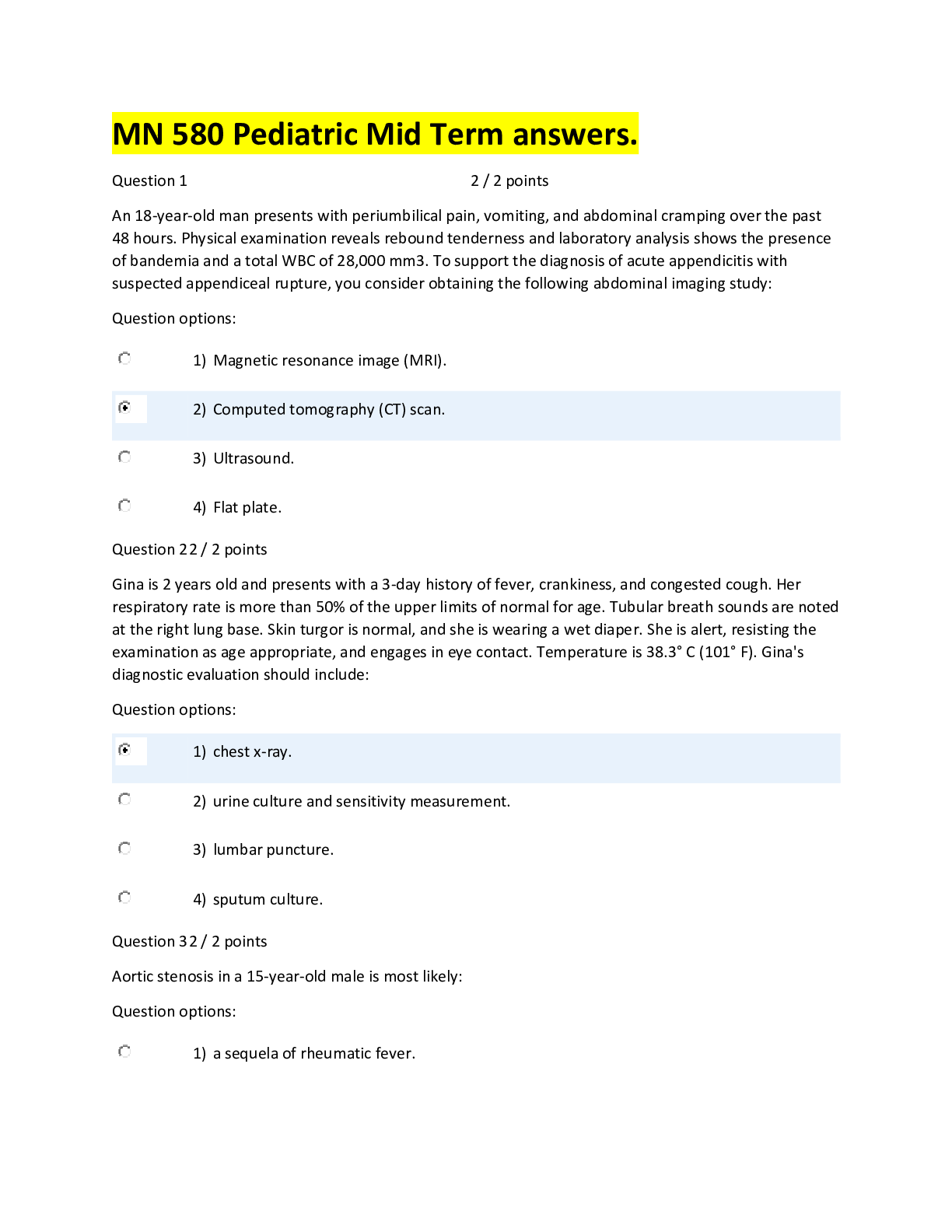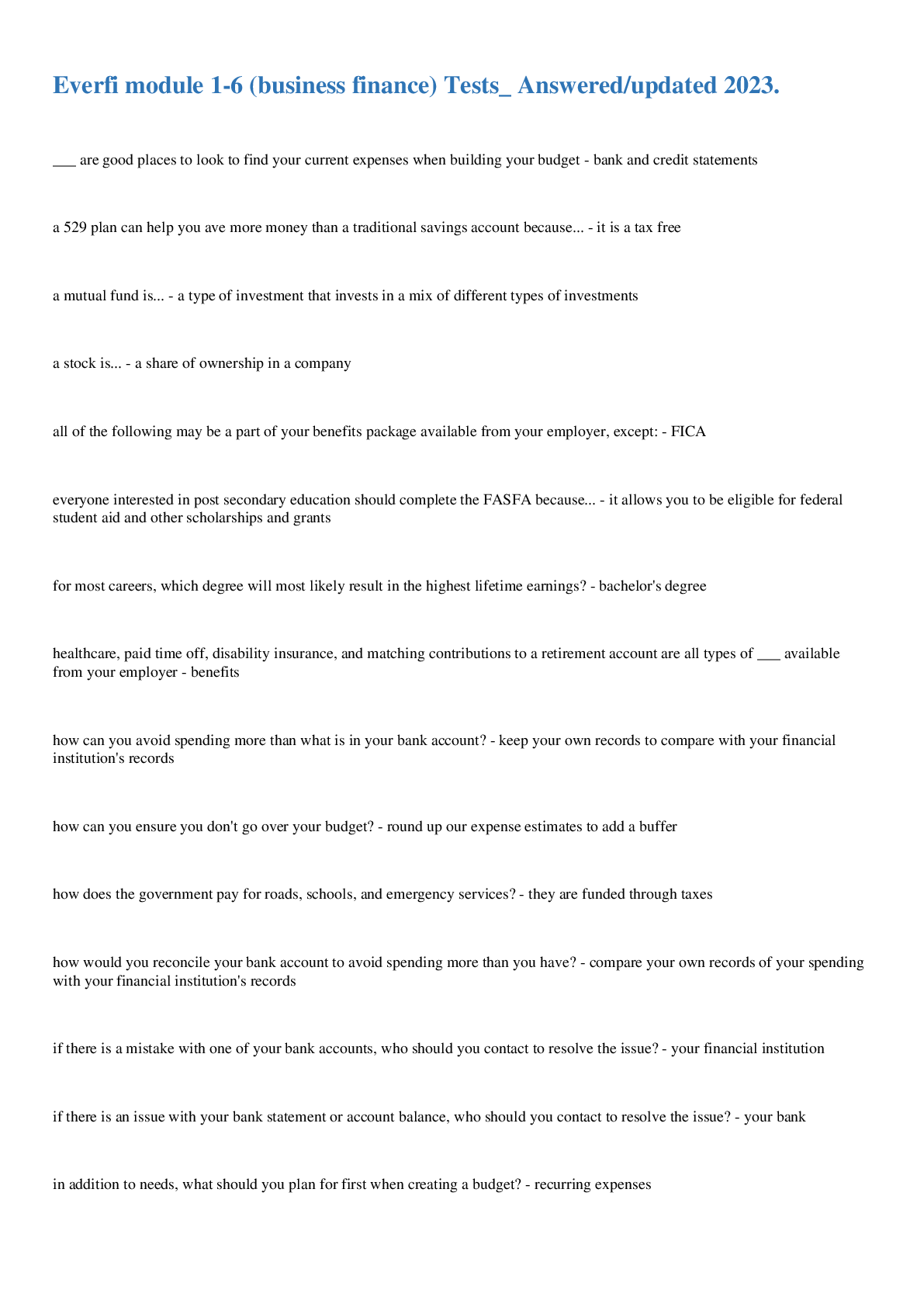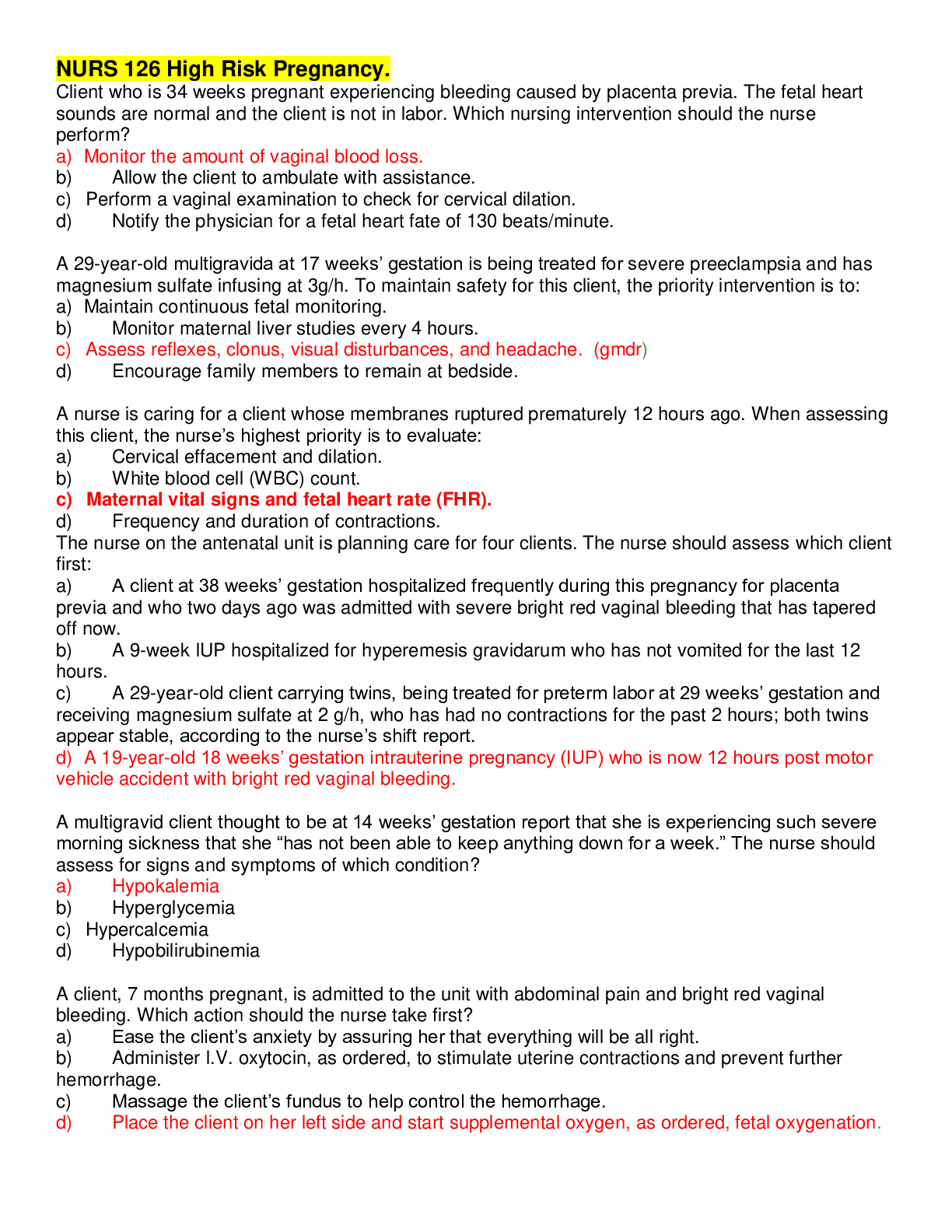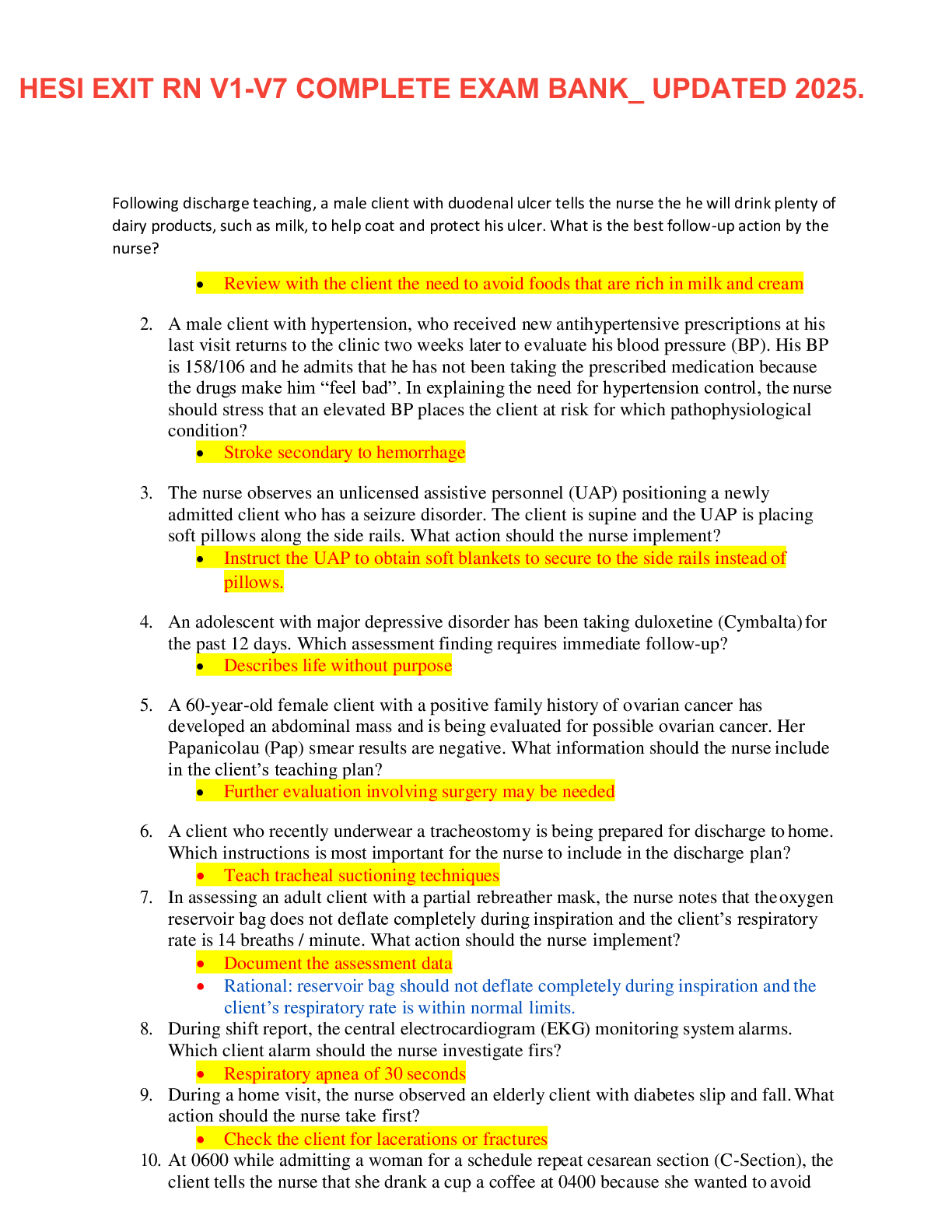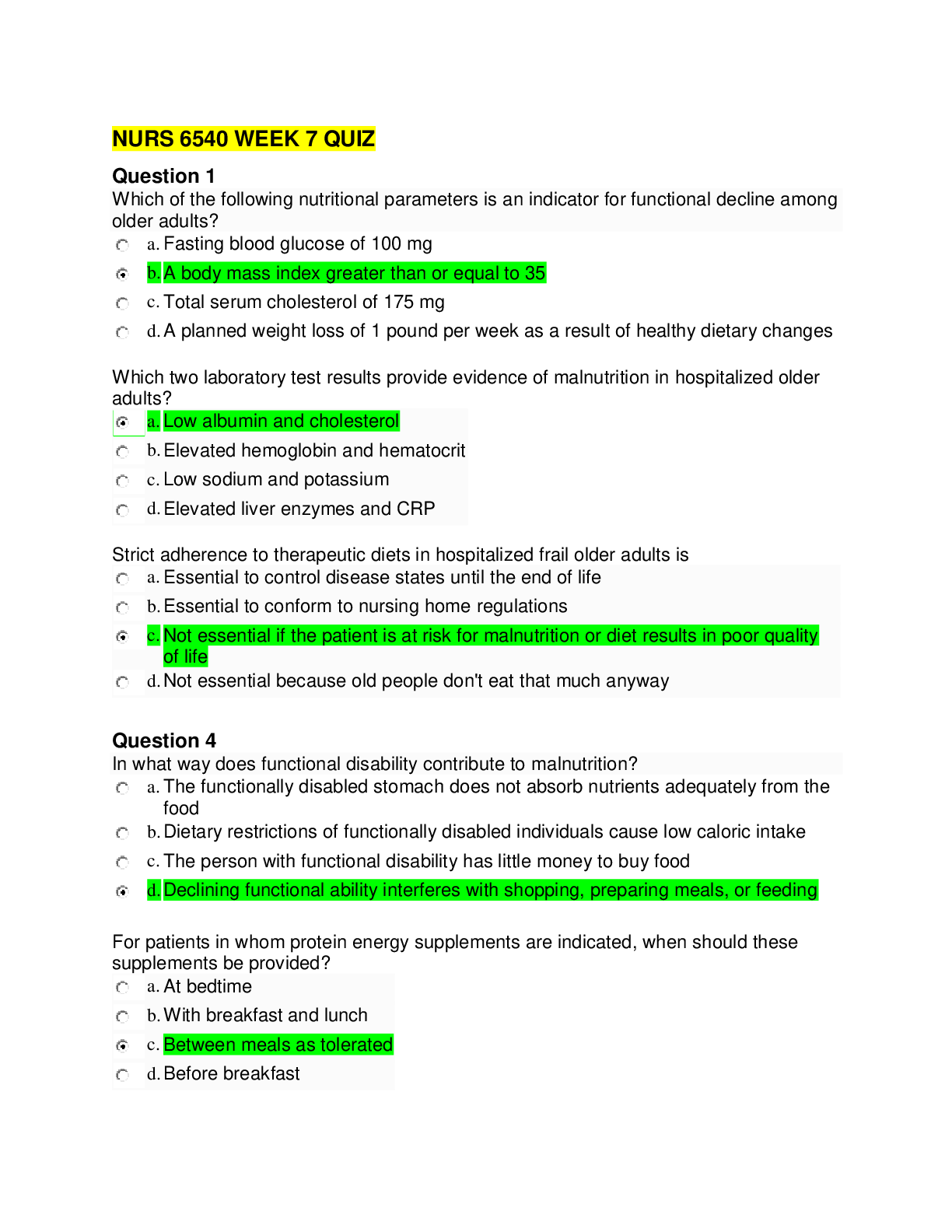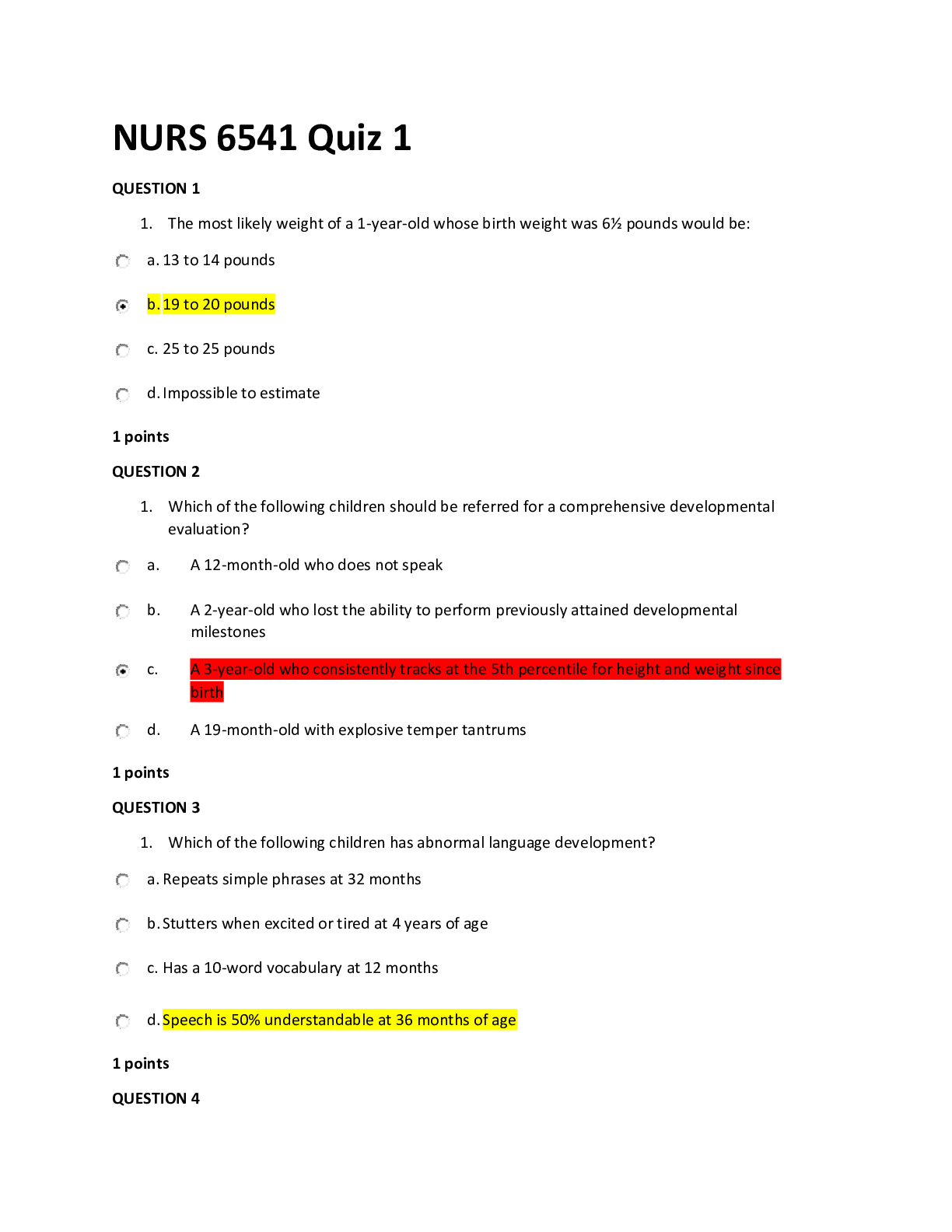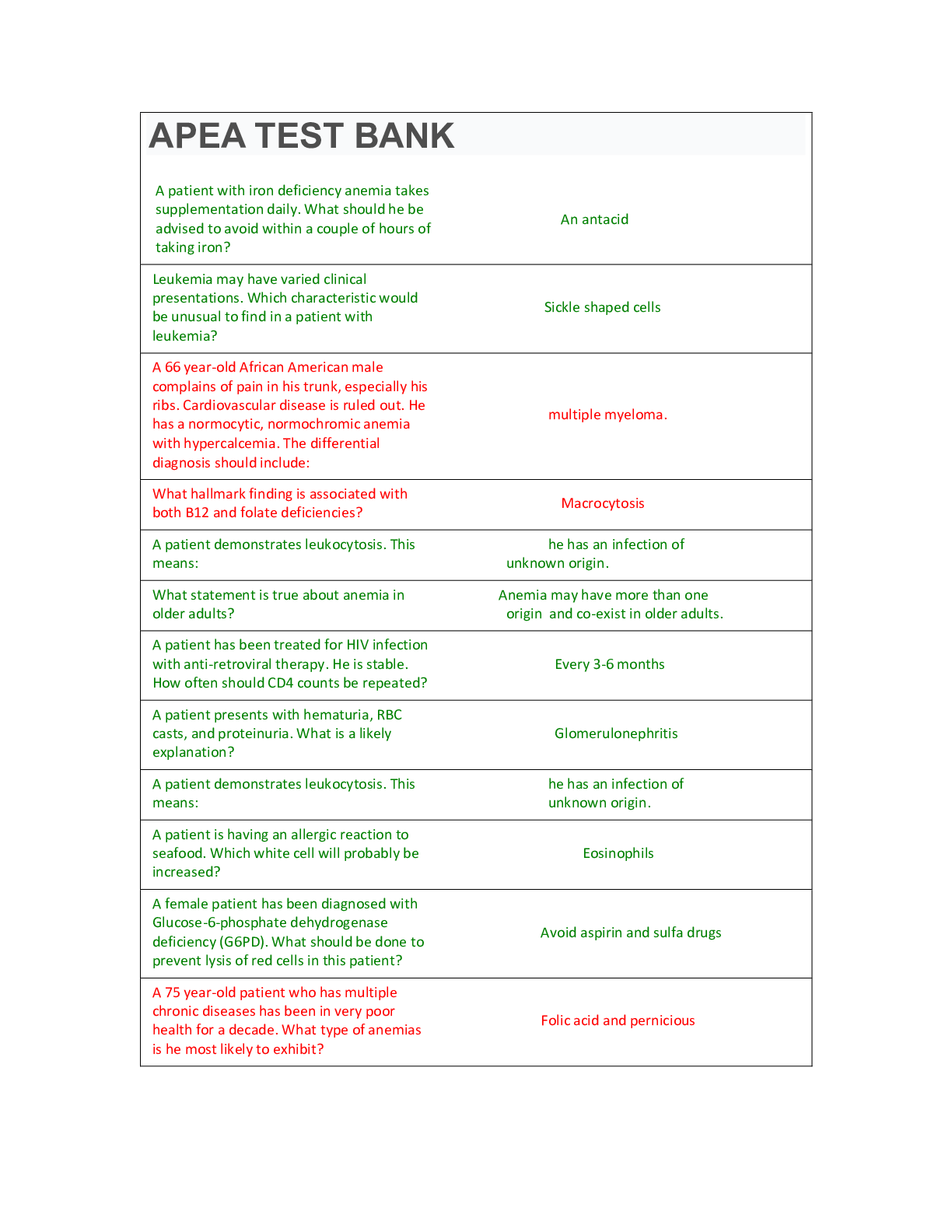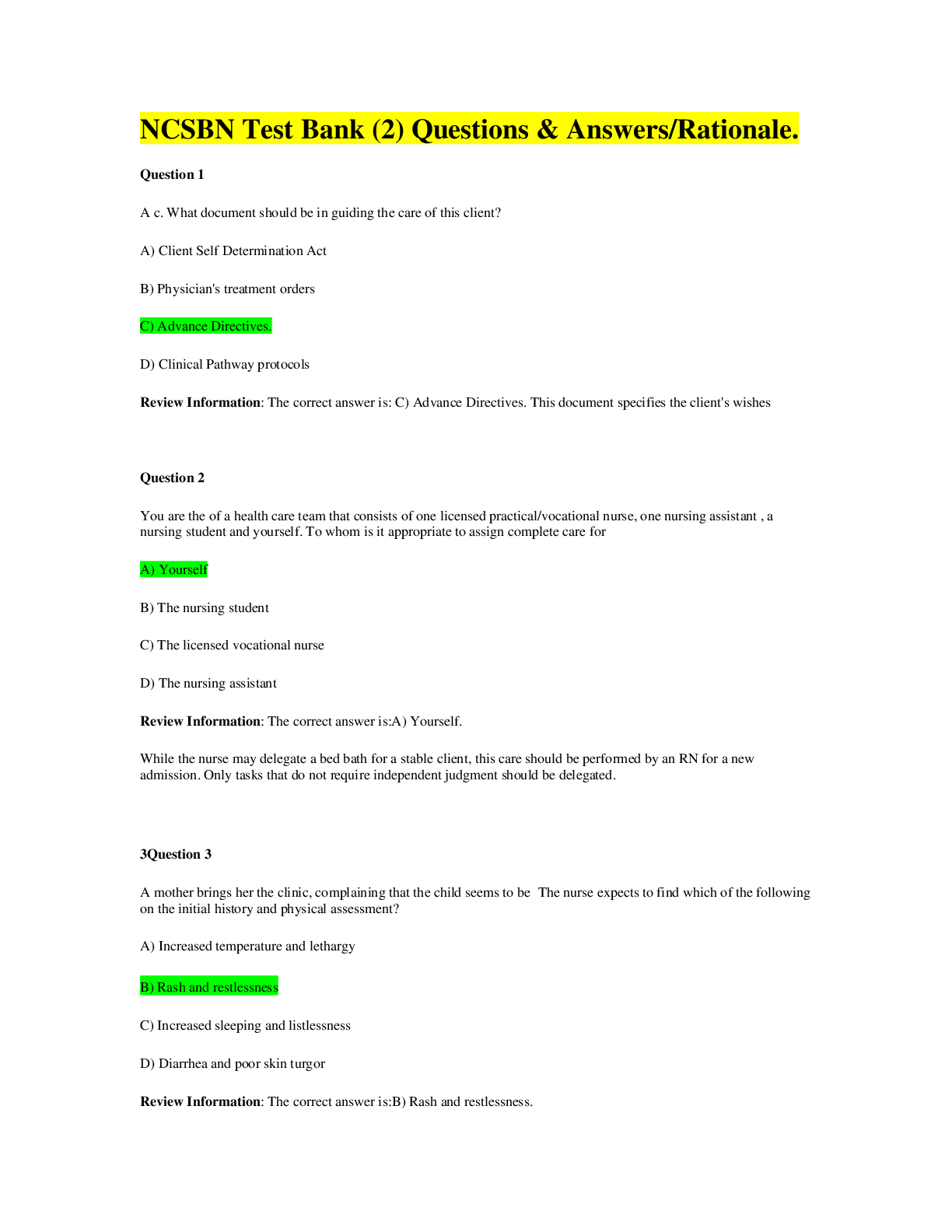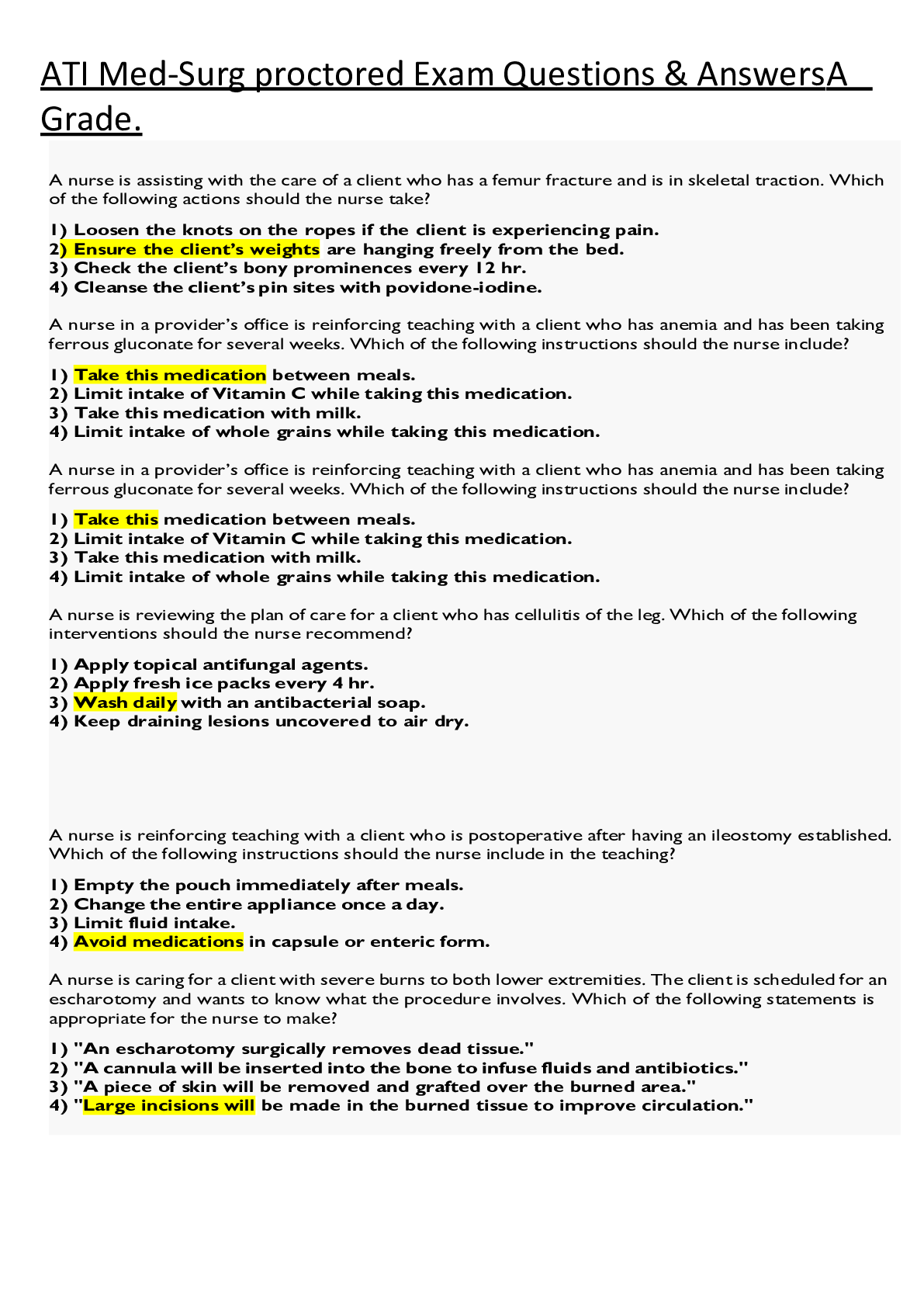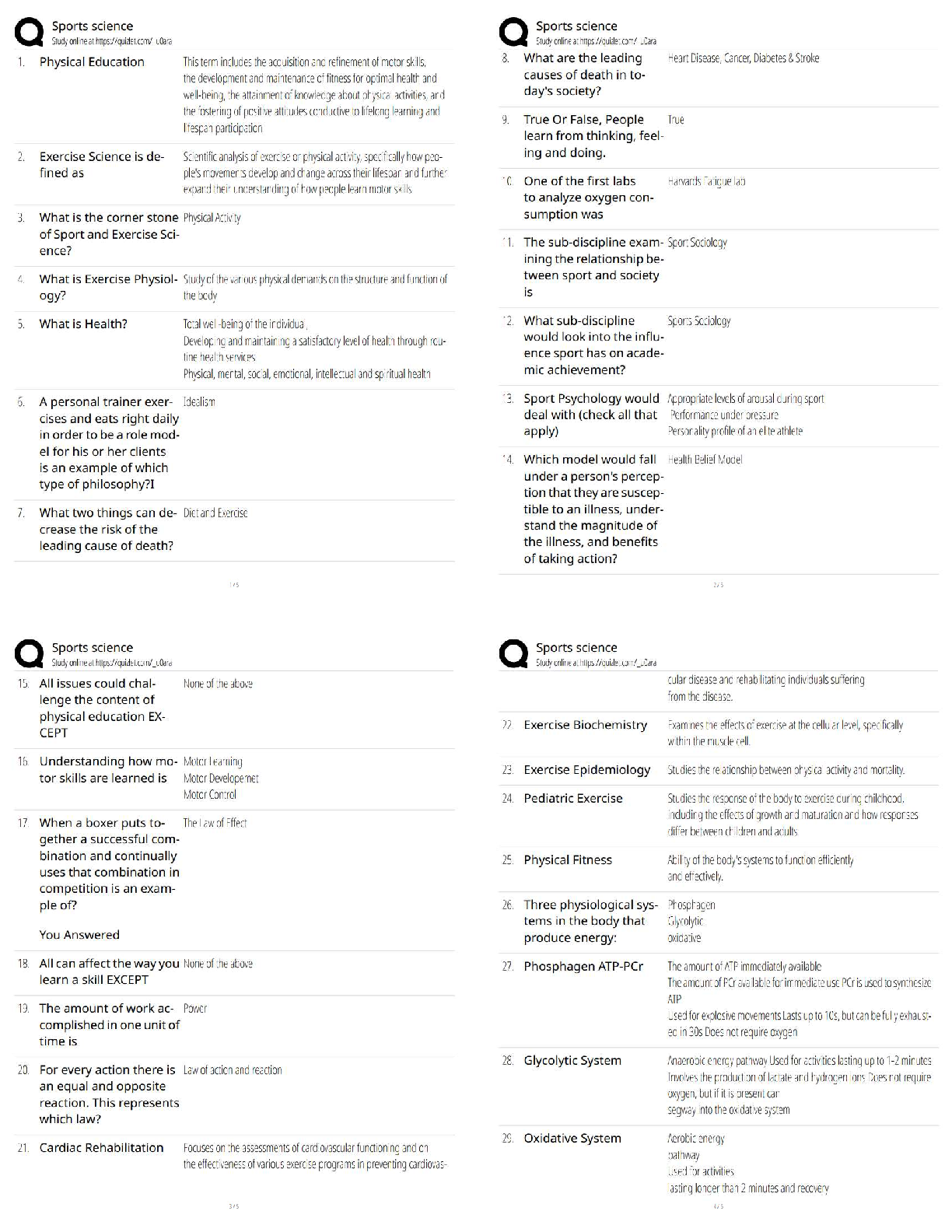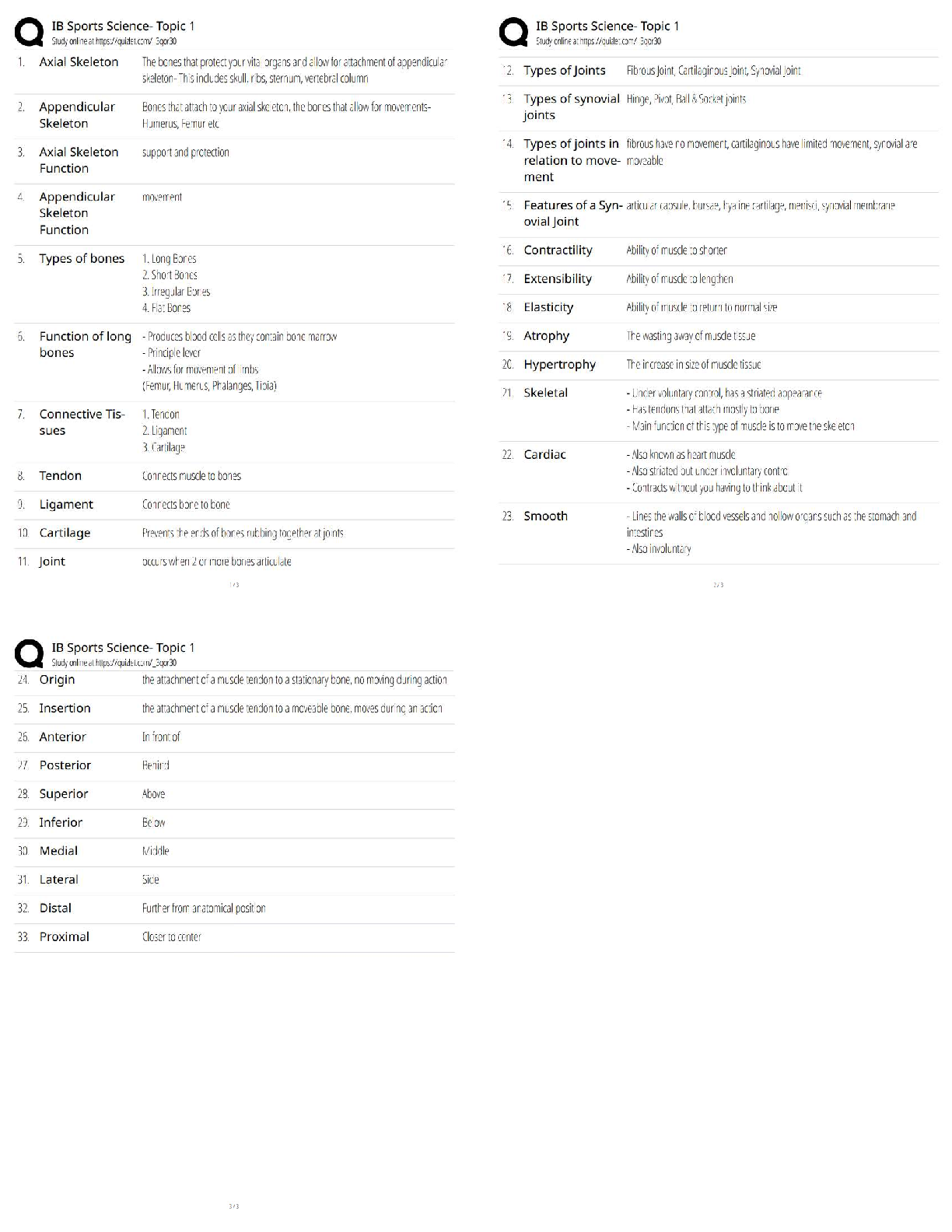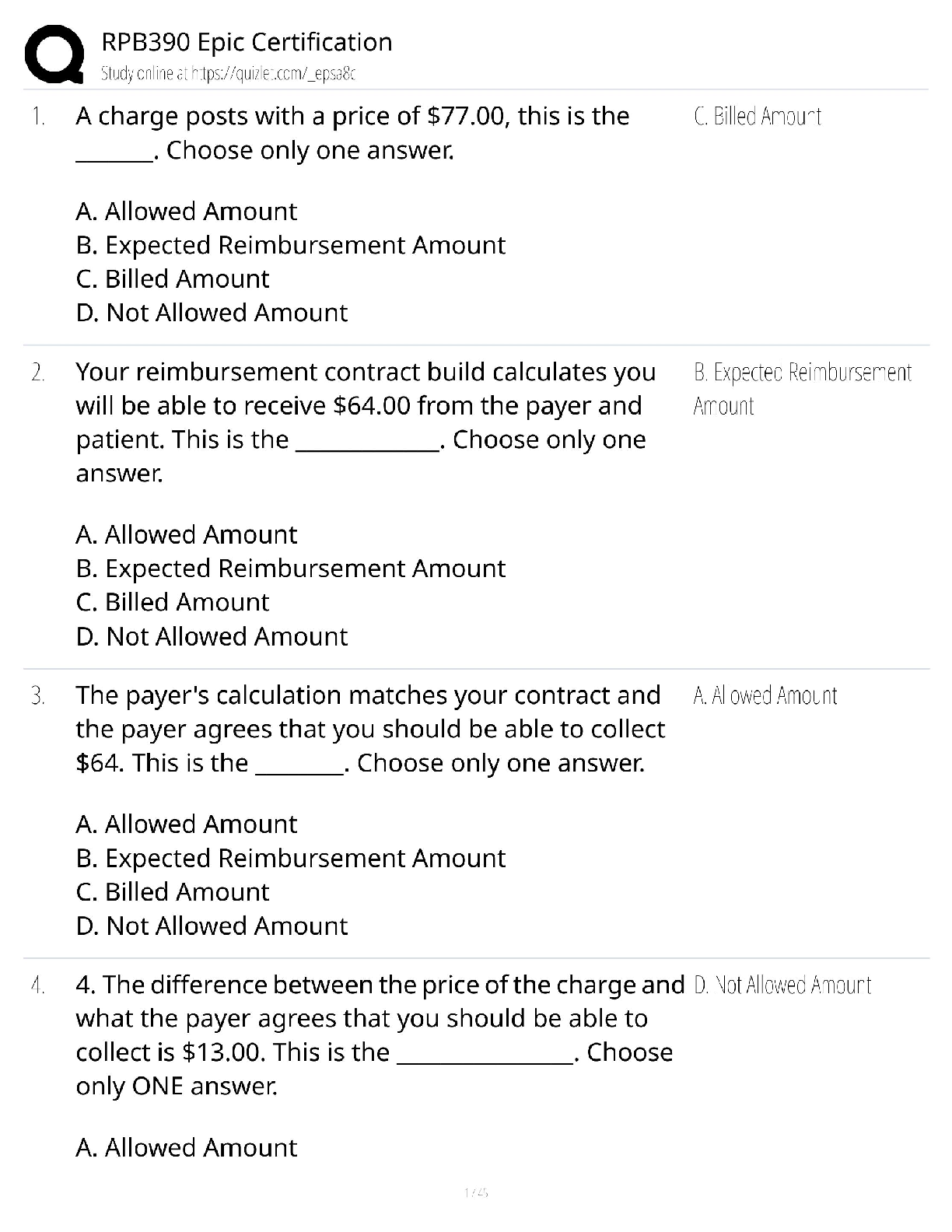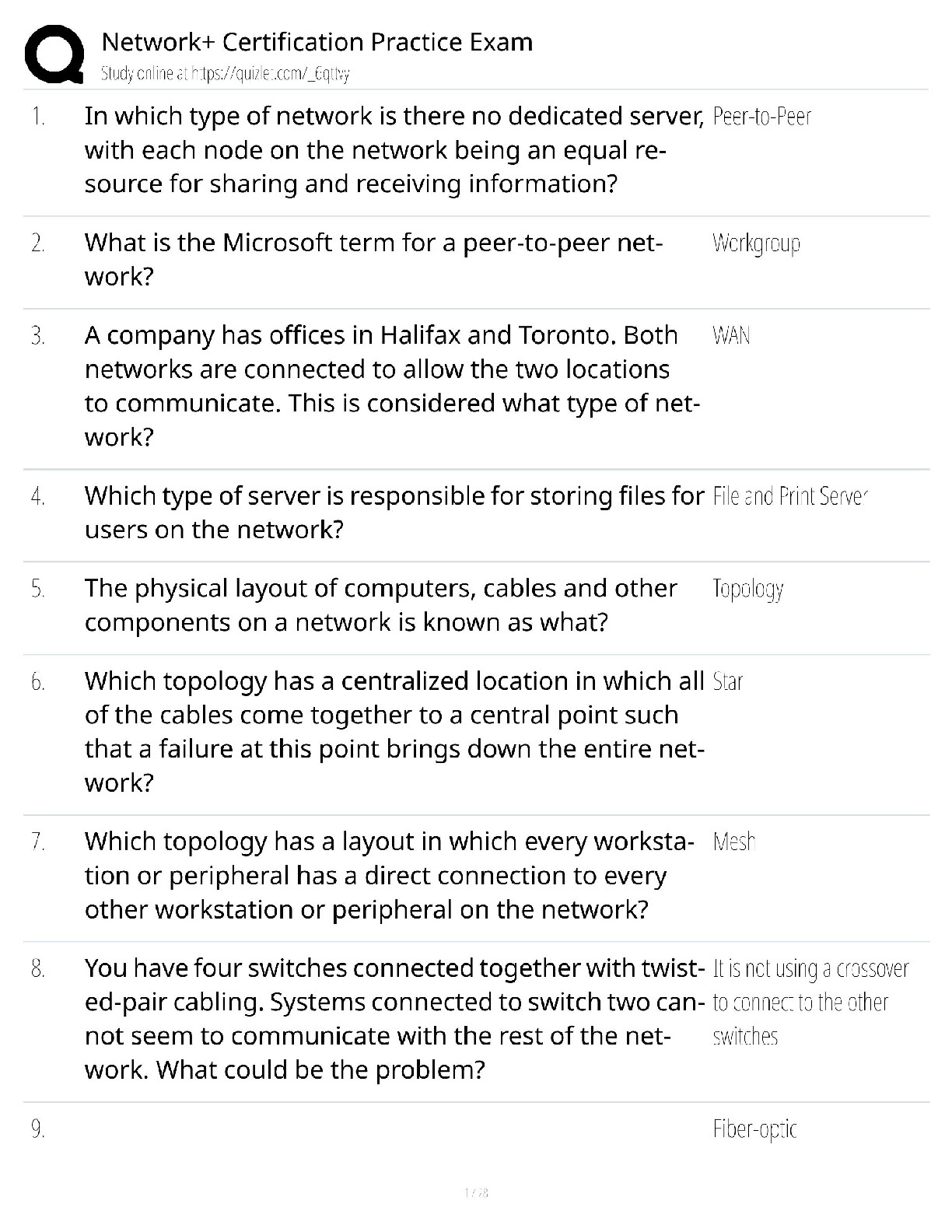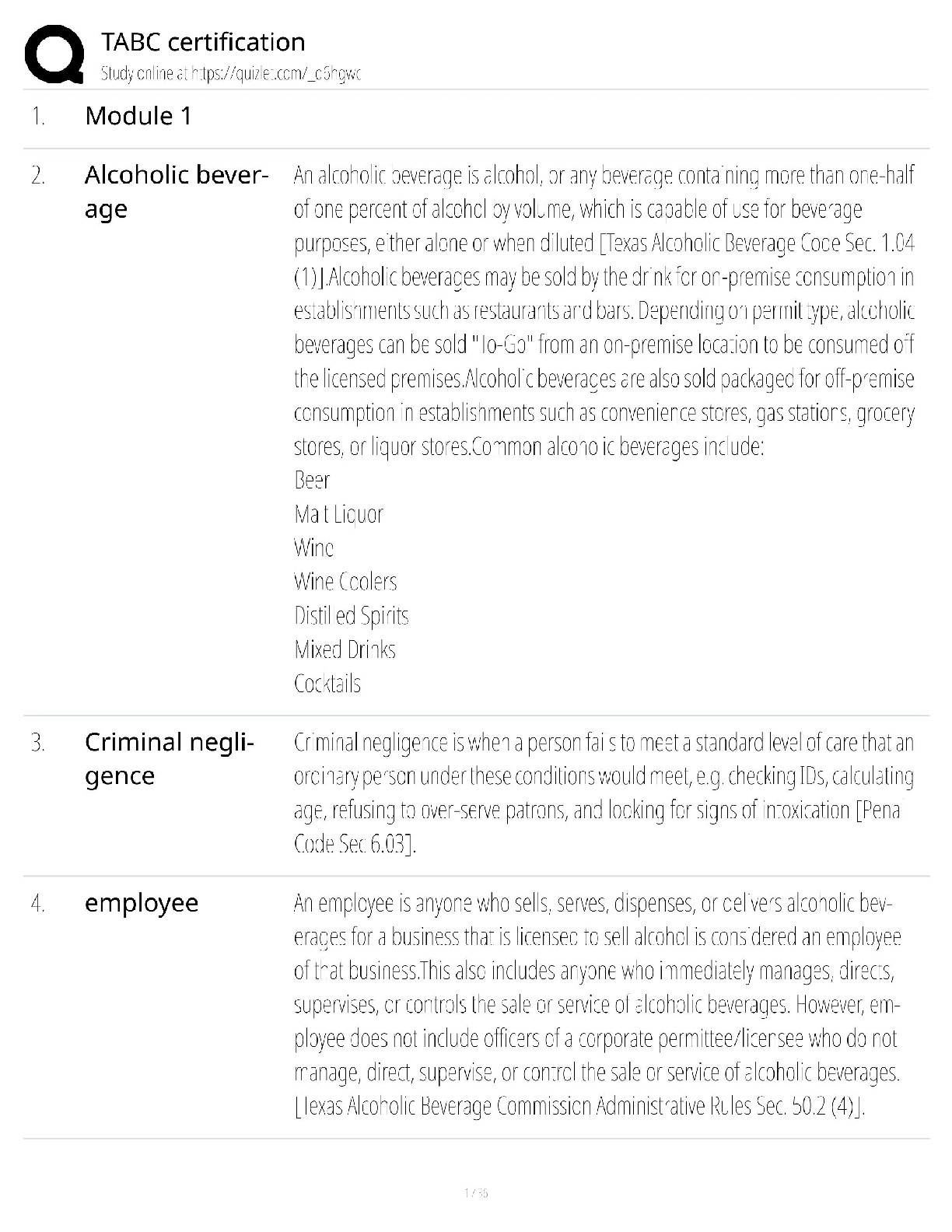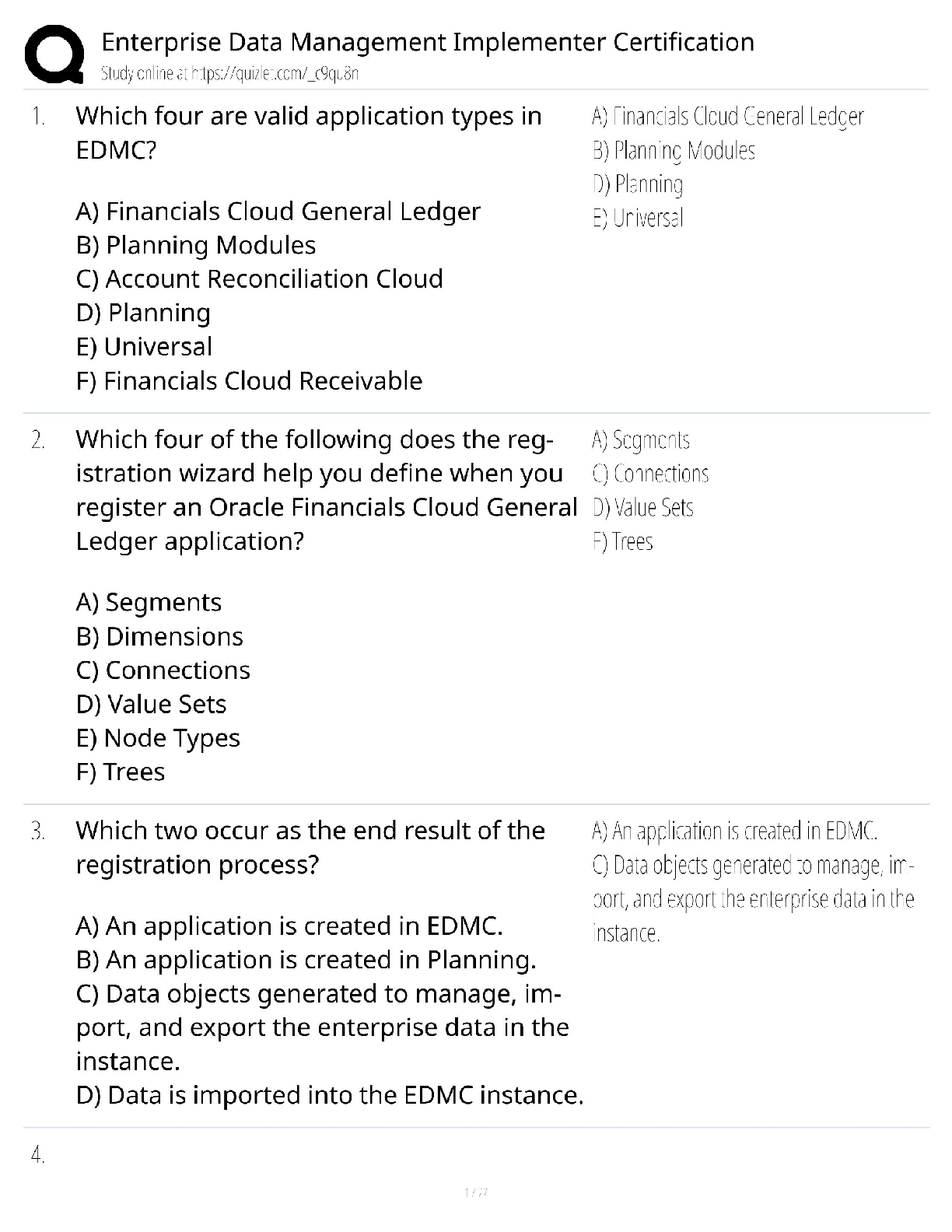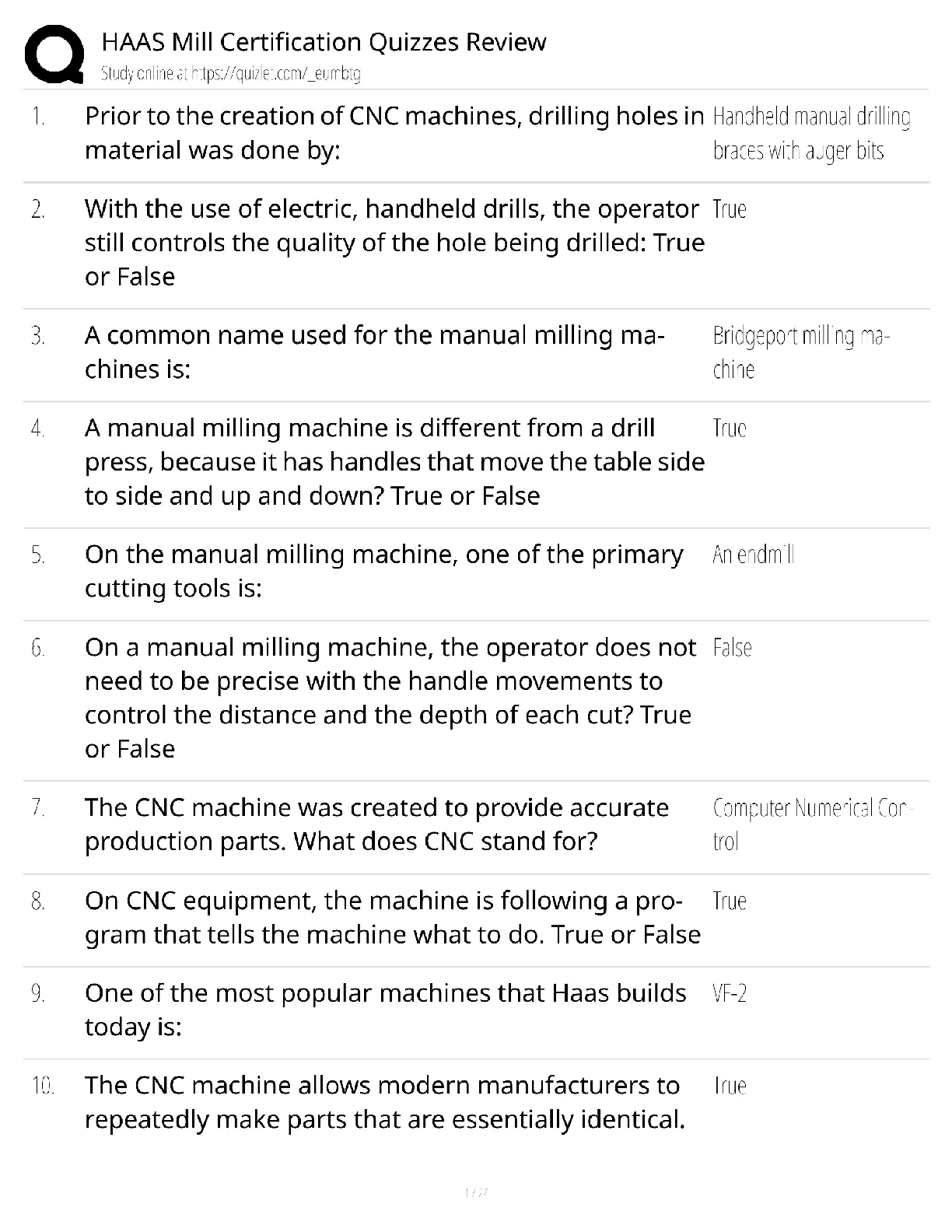Biology > QUESTIONS & ANSWERS > BIOS 390 - QUIZ BANK (QUIZZES 1-7) Latest 2019/2020 complete solution guide, Verified answers; A+ wo (All)
BIOS 390 - QUIZ BANK (QUIZZES 1-7) Latest 2019/2020 complete solution guide, Verified answers; A+ work - Devry University-Chicago.
Document Content and Description Below
BIOS 390 QUIZ BANK – QUIZZES 1-7 QUIZ 1 TCO 1) In 1953, James Watson and Francis Crick proposed Question 2 (TCO 1) In 1928, Frederick Griffith injected living S (smooth) Streptococcus ... pneumonia into mice, and the mice died. When he injected living R (rough) Streptococcus pneumonia into mice, the mice lived. When he injected heat-killed S bacteria into mice, the mice lived. What was the result when he mixed heat-killed S bacteria with live R bacteria and injected this mixture into mice? Question 3 (TCO 1) Beadle and Tatum’s “one gene-one enzyme” hypothesis was later revised to the Question 4 (TCO 2) What forms the “backbone” of a nucleic acid? Question 5 (TCO 2) The predominant form of DNA in vivo is Question 6 (TCO 2) The melting temperature (Tm) of DNA is Question 7 (TCO 2) Hairpin loops, base-paired stems, and bulges make up what part of RNA’s structure? Question 8 (TCO 2) A particular RNA chain Question 9 (TCO 2) Select the correct statement. Question 10 (TCO 2) The core octamer is composed of Question 11 (TCO 2) What statement is not true about plasmid DNA? Question 12 (TCO 1) Using the Hershey-Chase experiment as an example, list the hypothesis, observations, and the conclusion of this experiment. Question 13 (TCO 2) Distinguish between the terms “nucleoside” and “nucleotide.” What does dGTP stand for? Question 14 (TCO 2) List 2 features that distinguish eukaryotic genomes from bacterial genomes QUIZ 2 Which of the following statements is correct? Question 2 (TCO 3) Which of the following activities are unique for DNA polymerase I? Question 3 (TCO 3) Once bound to an origin of replication, the origin replication complex (ORC) recruits Question 4 (TCO 3) Pre-replication complex assembly Question 5 (TCO 3) Chromatin assembly factor 1 (CAF-1) is thought to aid replication by Question 6 (TCO 4) A missense mutation is one in which Question 7 (TCO 4) Which statement is true about the deamination of cytosine? Question 8 (TCO 4) In humans, double strand DNA damage is repaired by Question 9 (TCO 4) Base excision repair is initiated by Question 10 (TCO 3) Define the term “replication licensing” and its importance in DNA replication. Explain how this is achieved in a cell. Question 11 (TCO 3) Describe an example of “polymerase switching.” Question 12 (TCO 3) What two enzymes catalyze direct reversal of DNA damage? Briefly explain the mechanisms they use. Are both repair pathways present in human cells? Question 13 (TCO 4) Give example of a single base change and suggest how that change, if not repaired, will be detrimental to the host. QUIZ 3 Which statement is not true about DNA ligase? Question 2 (TCO 5) In recombinant DNA technology, the term competency refers to Question 3 (TCO 5) When doing blue-white screening, the blue color is produced by the hydrolysis of Question 4 (TCO 5) What primers are used for the synthesis of the cDNA from mRNA? Question 5 (TCO 5) What DNA sequence information is essential for the success of a polymerase chain reaction (PCR)? Question 6 (TCO 5) Find the incorrect statement. Question 7 (TCO 5) To analyze the results of a DNA sequencing reaction, which type of gel should you prepare? Question 8 (TCO 5) It is common to use ddNTPs (dideoxynucleoside triphosphates) for sequencing DNA because, when incorporated into a growing DNA polymer, the ddNTP acts as a chain terminator, allowing the researcher an opportunity to determine the last-added base to a given chain. From your knowledge of nucleotide structure and DNA synthesis, what is the most likely attribute of ddNTPs for DNA sequencing? Question 9 (TCO 5) What factors determine the annealing temperature in PCR reaction? Question 10 (TCO 5) Outline the steps to make a genomic library. QUIZ 4 (TCO 5)During a stable transfection, Question 2 (TCO 5) Epitope tags can be attached to proteins of interest. This helps Question 3 (TCO 5) The technique of in situ hybridization gives information about Question 4 (TCO 5) DNase I footprinting can be used for determining Question 5 (TCO 5) In an indirect immunofluorescence assay, which component is fluorescently labeled? Question 6 (TCO 5) Which of the following techniques can be used to study DNA-protein interactions in vivo? Question 7 (TCO 5) What is the difference between reverse transcriptase PCR (RT-PCR) and standard PCR? For what purpose would you use RT-PCR? Question 8 (TCO 5) In western blot analysis, once the proteins are transferred onto a membrane, how is the membrane developed to show the protein on interest? Question 9 (TCO 5) Describe three different uses of reporter genes. 1) To measure the activity of a promoter or other regulatory region. 2) To measure the efficiency of delivery systems of gene. 3) Measure protein-protein interactions. Answers may vary: Analysis of gene expression; fusion proteins for purification; fusion proteins for localization in a cell. Chapter 9 QUIZ 5 (TCO 6) Transcription proceeds in the Question 2 (TCO 6) Promoter is located Question 3 (TCO 6) Which of the following statements is correct? Question 4 (TCO 6) Rho-independent terminators have all of the following characteristics except: Question 5 (TCO 6) Full induction of the lac operon occurs when Question 6 (TCO 6) Transcription of protein-coding genes in eukaryotes is carried out by Question 7 (TCO 6) Elongation of transcription requires Question 8 (TCO 7) RNA splicing is the process by which introns are removed from a primary RNA transcript at precisely defined splice points. Which statement is not true about introns? Question 9 (TCO 7) During maturation of nuclear pre-mRNA in eukaryotes, capping takes place at the Question 10 (TCO 7) The process of polyadenylation is accomplished by Question 11 (TCO 7) RNA interference is thought to have evolved to Question 12 (TCO 6) For bacterial operon induction, describe a specific example of the following: “The repressor and activators are DNA binding proteins that undergo allosteric modification.” QUIZ 6 (TCO 8) Ribosomes carry out the process of protein synthesis in the _____ after assembly in the _____ within a special compartment called the _____. Question 2 (TCO 8) Transfer RNAs get charged with amino acids Question 3 (TCO 8) Hydrolysis of ATP indirectly fuels protein synthesis by Question 4 (TCO 8) Initiation factors with helicase activity (eIF4G, eIF4E) associate with Question 5 (TCO 8) The signal recognition particle (SRP) is a ribonucleoprotein complex that binds to ribosomes translating polypeptides that bear a signal sequence for targeting to Question 6 (TCO 8) In response to unfavorable conditions, such as hypoxia or osmotic shock, translation can be globally repressed by Question 7 (TCO 8) Many steps in gene expression and cell signaling involve post-translational modification of proteins by Question 8 (TCO 8) Alzheimer’s disease, Huntington’s disease, and Creutzfeldt-Jakob disease are all examples of Question 9 (TCO 9) When making a transgenic mouse by microinjection of foreign DNA into fertilized eggs, Question 10 (TCO 9) The term reprogramming refers to Question 11 (TCO 9) Plasmids are used as vectors in both plant and bacterial recombinant DNA technology. However, there is a major difference in the fate of genes introduced into bacteria on most bacterial plasmids and into plants on Ti plasmids. What is this difference? Question 12 (TCO 8) Describe possible fates for a misfolded protein in a cell. QUIZ 7 TCO 10) Repeat length for minisatellite is Question 2 (TCO 10) Forensic DNA typing often involves recovery of very tiny amounts of DNA from a crime scene. What is a major concern in analyzing this DNA? Question 3 (TCO 11) The process by which cancer cells travel from the tissue of origin to other parts of the body is called Question 4 (TCO 11) Normal cells undergo _____ and become cancerous. Question 5 (TCO 11) What is an oncogene? . Question 6 (TCO 10) List two differences between minisatellites to microsatellites. Why is analysis in microsatellites more widely used? Question 7 (TCO 10) Discuss the role of protein arrays in high throughput analysis of gene function. Question 8 (TCO 11) Distinguish between “oncogenes,” “proto-oncogenes,” and “tumor suppressor genes.” [Show More]
Last updated: 3 years ago
Preview 1 out of 18 pages

Buy this document to get the full access instantly
Instant Download Access after purchase
Buy NowInstant download
We Accept:

Reviews( 0 )
$16.50
Can't find what you want? Try our AI powered Search
Document information
Connected school, study & course
About the document
Uploaded On
Feb 26, 2020
Number of pages
18
Written in
All
Additional information
This document has been written for:
Uploaded
Feb 26, 2020
Downloads
0
Views
142

